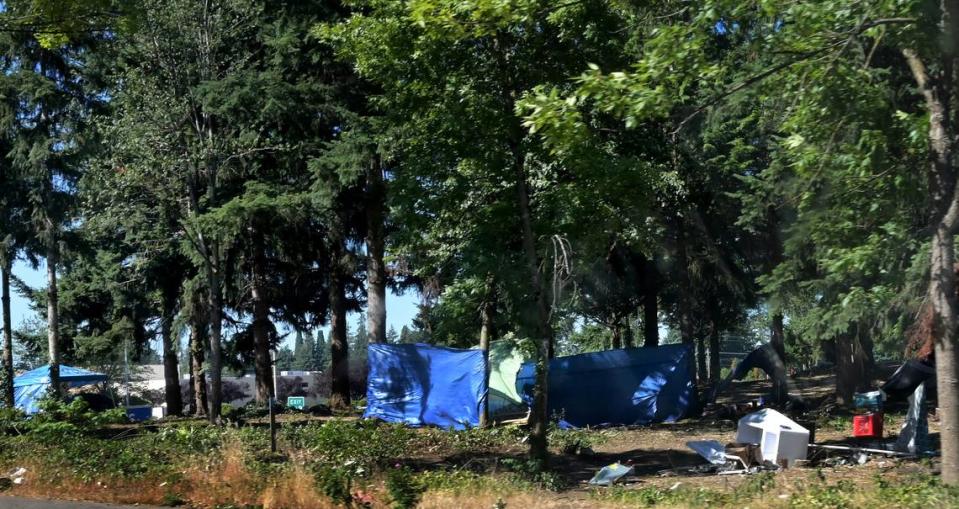Initiative to house people displaced by freeway cleanups gains momentum in Thurston County
A plan to house people camped near Thurston County freeways has started to pick up momentum with the opening of a new shelter.
Maple Court, a former hotel located on Quinault Drive at Marvin Road in Lacey, began accepting its first residents the last week of June. In the weeks to come, the shelter’s 118 rooms will be filled with people from sites along Interstate 5.
The opening of the hotel represented a local milestone for Gov. Jay Inslee’s Rights of Way Initiative. This effort began a year ago, but it’s been slow to relocate people in Thurston County until recently. Thomas Webster, program manager for the county’s Office of Housing and Homeless Prevention, said about 88 people had been relocated as of Thursday.
About 38 of that total had recently moved into Maple Court, he said. Interfaith Works has served 35 people at its Unity Commons shelter on Martin Way, and Safe Place has helped 15 people, who are fleeing domestic violence, stay in hotel rooms, he said.
“There was a push from (the Washington state Department of Commerce) with a lot of funding to move really quickly to house folks,” Webster said. “And I think we realized that it just takes time to create the housing units that we wanted to move people into.”
In all, the state has spent or allocated a total of $40.2 million for the Rights of Way Initiative in Thurston County through June 30, 2025, Webster said.
However, that total may change depending on future legislative authority, according to Penny Thomas of the Washington state Department of Commerce.
As it stands, Webster said the funding includes $13.2 million for Thurston County, $7 million for the City of Olympia and $20 million for the Low-Income Housing Institute, which manages Maple Court.
LIHI used its share to acquire the former Days Inn hotel and convert it into Maple Court, according to City of Lacey information. Another $4 million will be used for two years of site operations at Maple Court.
The remaining amount has gone toward a variety of other projects and services, including a tiny home village in Olympia that’s set to open this year.
What’s happening at the encampments?
Thurston County has contracted with Olympia Mutual Aid Partners (OlyMAP) and partnered with the City of Olympia to conduct outreach at five Rights of Way encampments next to Interstate 5 at Lilly Road, Pacific Avenue, Sleater Kinney Road, Wheeler Avenue and the City Center exit.
The Lilly Road site has been cleared, but a couple remains on the Pacific Avenue site, Webster said. At the moment, he said local officials are primarily focusing on moving people from the Sleater Kinney site to Maple Court.
Keylee Marineau, the county’s Homeless Response Program Manager, described the work being done by outreach workers in a June news release.
“For the last year, outreach workers have been doing tremendous work building rapport with residents of camps and sharing what housing options are available to them,” Marineau said. “This work is vital. It must be done with compassion and care; and it takes time.”
OlyMAP estimated there were about 250 people still at encampments as of July 13, Webster said. While outreach workers continue to connect with people, not all may be placed in shelters. Those who refuse the available offers will eventually be treated as trespassers by Washington State Patrol, he said.
That could be the fate of the couple at the Pacific Avenue site. Webster said the couple have high acuity needs — which means their condition is severe and imminently dangerous — that’s made it challenging to find them appropriate housing.
“The state has allowed them to stay for a little bit longer, but they will be offered Maple Court or they’ll be trespassed here in the coming weeks,” Webster said.
Others at the sites may be trespassed because they moved onto the sites too late to be placed on a list for the initiative. Webster said there may be about 50 people at the Sleater Kinney site who moved there after a May deadline set by the state.
Those who are trespassed could seek housing through the county’s often-strained coordinated entry system, which prioritizes people based on their status and level of vulnerability.
“The reality is, there probably aren’t other places for them to go in our community,” Webster said. “Everything is full.”
The coordinated entry system now has four lists that include 650 single adults, 208 families, 165 people affected by domestic violence and 90 youth 18-24 years-old, Webster said on Thursday. He cautioned there may be some overlap or duplication among the lists.
After a site is cleared of occupants, Washington State Department of Transportation crews clean and repair the area, according to WSDOT spokesperson Barbara LaBoe.
Crews also work with landscape architects to modify the site in a way that prevents it from being reoccupied, LaBoe said. This can include clearing vegetation, adding fencing or adding large rocks.
“Some or all can be used on a given site,” LaBoe said. “If we notice any signs of people reoccupying a site after the work is done, we reach out to law enforcement partners.”
Chris Loftis, communications director for the State Patrol, said troopers will direct people to leave the sites as necessary. Troopers may arrest someone who occupies a site in “extreme cases,” but he said that would be the “least desirable” outcome.
“We recognize the housing crisis, the unhoused crisis, all those issues are significant,” Loftis said. “They’re real. They’re complex. But we deal with a more simple situation. It is not safe on the side of the road. We need to move along.”

More housing on the way
More beds for the Rights of Way Initiative will become available this summer. Darian Lightfoot, director of housing and homeless response at the City of Olympia, said construction of 50 tiny homes at 528 Franz Anderson Road is expected to be completed by the end of August.
OlyMAP will operate the tiny homes, which are on city-owned land, Lightfoot said.
On July 11, the Olympia City Council approved a $1-per-year lease agreement with the non-profit and agreed to cover up to $994,262 in operations costs through June 2024, according to city documents.
Lightfoot said the city has spent about $3 million in pass-through funding from the state on the Franz Anderson Tiny Home Village site so far, but that sum includes costs to prepare the area for a new permanent supportive housing project across the street.
“We’re really grateful for the financial support from the state and excited that we’re seeing a lot of people get housed,” Lightfoot said.
However, Lightfoot said working on the Rights of Way Initiative while maintaining the local coordinated entry system has been challenging. The initiative calls for service providers to offer housing to people who have been living at specific sites, but Lightfoot said the approach can actually draw people to those sites.
“It’s been a shift and it’s caused service providers locally to kind of pivot from what they traditionally do, which is more of an equity-based model, vulnerability-based model … and now pivoting to a site-based model,” Lightfoot said.
Looking ahead, Lightfoot said the city expects many of the people at the Wheeler site to transition to the tiny home village later this year.
The village will stay standing for about three years while the permanent supportive housing is completed, The Olympian previously reported. Once that happens, the village is planned to be decommissioned and its residents will move into the new building.
Similarly, Webster said the county expects Maple Court to be converted into permanent supportive housing in two to four years. However, he said it’s not yet clear how that effort will be funded.
“We don’t want to exit people after two years, kick them out of the hotel, and then they’re back on the street,” Webster said. “Folks will either move into housing (elsewhere) or (Maple Court) will be turned into permanent housing for people.”


